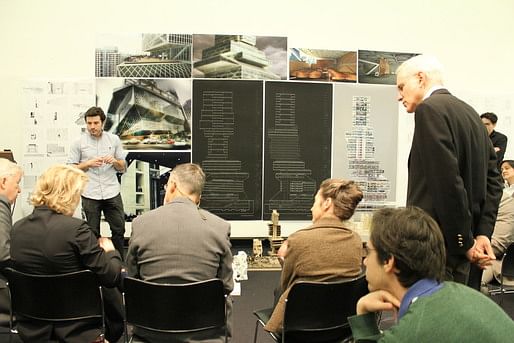
Hi Archinect,
Okay, we're only an hour behind schedule.
12:00: Trey Kirk begins, describing Mies' seminal courtroom design, with a cell off of each courtroom; and a typology of courtrooms since then. In the internal programming for courtrooms, double-height courtrooms and single height judges' chambers often creates a great deal of vertical poché space. The "worst culprit" is Vinoly's building, with five secure cores to keep prisoners from...from..
Jeff Kipnis: from getting free--
TK: from interacting with the public, yes.
TK: If we go to Mies, he has two typological spaces; the thickened corridor and the main lobby which is the open space that is rarely activated. ...For a new construction, we still have the issue of the poché, the 12' of nothing-space. The idea is [to stack the spaces differently and to allow different strategies that relate to each courtroom type--family, tax, criminal].
...So there's two games being played, the courthouse access and the distributed lobby.
Because criminal court is the secure court, extrusion isn't the efficient form. The secure elevators can bypass the civil court. The most important part of the project is the civil registry, which functions like the Seattle Public Library but for court functions.
CI: Did you end up creating any new poché, or have you captured all the programs...by packing the system in a very particular way?
TK: The leftover space is this microlobby, the new civic space.
JK: Do you have a new net-to-gross calculation?
WJ: It's not net-to-gross, it's net-to-volume.
WJ: The other half is the beauty of the architectural result. He's told us how this happened, squeezing out every extra cubic inch of volume, recovering what you can't squeeze out and making a new progrm out of that.
CI: But it's interesting what programs you end up with...
WJ: Do you need a library? It's an excuse for--
JK: I wish we could keep going, because I was learning so much. Is it specific to Seattle Public Library?
TK: It was a new prototype.
JK: The hoop of wanting to go through the exiting problem....
...Is there such a thing as a hypercore?
HC: No, it's a core.
JK: Because in Star Trek, you need dilithium for a hypercore. Anyways, I have to go--but I'm so happy with the state of the school--and this was incredibly fun. [Jeff Kipnis departs.]

IR: I think you need the library, frankly: reason one is you need the sloping public realm of the library, which is the question mark of the library, because you need it for access to the security core. That is regrounding the courthouse within an interiorized public domain. The other thing is an ungrounding, at the same time, of the typology of the high rise.
WJ: I would like to make a plea again for the serious, which you did so much work to resolve, as a model. You're sort of smearing Mies and Kahn together, but if you can take a model that has inherent in it some tensions, and make that the architectural problem without the convenient answers that Koolhaas gives you. But force yourself to make a base for this. As Inge is saying--
TK: I think the project is weaker but the message is stronger using Seattle.
WJ: You're cheating by borrowing from Rem.
Rodolphe el-Khoury: It's rhetorical.
IR: Where I don't believe you is in the core, [the problem is spread out vertically but it's still a problem].
REK: I'm not going to go back to Toronto and tell my partner that this guy worked so hard to work out the cores...I'm going to say that this guy put a tower on OMA's library; that's the provocation.
IR: To me this is the most radical and rhetorical model. Why did you start shifting this around.
REK: That's why it's brilliant, it's not just a gratuitous use of Koolhaas' library.
WJ: But he could have tried to resolve it symmetrically, in balance and everything. But he chose to shake it up, with freedom--
PSC:--it's not with freedom. Trey, people think that this is voluntary.
TK: 100%.
IR: Scott would have liked you to say that it's not.
CI: It had to be a civic institution, a repository of knowledge...it's all rhetorical. The project is trying to not succumb to this in a soft "cultural goodness" way, but trying to see what the determinants are. The library is not instrumental. It's structually determinant but also...
HC: Is our society and culture so impoverished, that the only way we can think to give a courthouse a public dimension is to squish it into a library? I think it's a very interesting project but... There are three populations: prisoners, judges, and public--that's all you had to say. What's problematic for me is that the library is being enlisted to give the courthouse its public dimension.
CI: The answer is that yes, it is.
REK: The courthouse has always attached to other institutions.
HC: There's an enormous problem--Mies' courthouse was the problem, not the solution.
...
Thanks for reading!
Lian
This blog was most active from 2009-2013. Writing about my experiences and life at Harvard GSD started out as a way for me to process my experiences as an M.Arch.I student, and evolved into a record of the intellectual and cultural life of the Cambridge architecture (and to a lesser extent, design/technology) community, through live-blogs. These days, I work as a data storyteller (and blogger at Littldata.com) in San Francisco, and still post here once in a while.



1 Comment
he could have used 3 shifting boxes rather than taken the library literally. I agree that borrowing the library is a bold move.
Block this user
Are you sure you want to block this user and hide all related comments throughout the site?
Archinect
This is your first comment on Archinect. Your comment will be visible once approved.